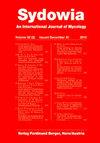Some new or interesting Physoderma species from India. II.
IF 1.2
4区 生物学
Q4 MYCOLOGY
引用次数: 3
Abstract
India. H. By M. S. Pavg i & M. J. T h i r u m a l a c h a r , (Banaras Hindu University and Malleswaram Bangalore, India.) ..,-.. :...-. : . ; , With plate IV—V. ..},,. In a recent paper (1954) the writers described some of the interesting species of Physoderma collected from different parts of India, including two new species, Ph. dichanthicolum and Ph. brachiariae. The study of Physoderma species have evoked considerable interest, primarily because it is a member of the chytriaceous group, and secondly of their rarity and interesting life-cycle. Their rarity may to some extent be due to the fact that many of the species incite very incospicuous Symptoms and are easily overlooked in the field. Few others such as Ph. alfalfae, Ph. aeschynomenae and Ph. limnanthemi though incite conspicuous gall formations, are either subterranean or produce galls in submerged parts of the plant, so that it is by accident that one comes across with these forms. All collections of materials f or the present study have been made in the neighbourhood of the Banaras Hindu University. As was pointed out in previous paper, species of Physoderma are most commonly met with in particular habitats. They are mostly found in low lying patches in the fields which become water-logged during the rainly season between July to September. The plants that are submerged become exposed during September-October when the small puddles begin to dry up. In species such as Ph. aeschynomene the region of infection on plant become specifically demarcated to the submepged parts only. In the present study accounts of seven species of Physoderma are presented. They all produce inconspicuous spots on the hosts and none of them incite systemic infection. The type specimens of the new species have been deposited in the Herb. Crypt. Ind. Orient., New Delhi, Herb. C. M. L, Kew, England and Mycological Division, U.S.D.A., Beltsville, Maryland, U.S.A.来自印度的一些新的或有趣的植皮类植物。2
印度。作者:m . S. Pavg & m . J. T .这是一篇关于印度巴纳拉斯印度教大学和印度班加罗尔马勒斯瓦拉姆大学的文章。:…-。: . ;,带板IV-V…},,。在最近的一篇论文(1954年)中,作者描述了从印度不同地区收集的一些有趣的Physoderma物种,包括两个新种,Ph. dichanthicolum和Ph. brachiariae。对藻皮菌的研究引起了相当大的兴趣,主要是因为它是壶菌科的一员,其次是因为它们的稀有和有趣的生命周期。它们的罕见可能在某种程度上是由于许多物种引起非常不起眼的症状,在野外很容易被忽视。很少有其他植物,如紫花苜蓿、紫花花和limnanthemi,虽然能引起明显的胆形成,但它们要么在地下,要么在植物的水下部分产生胆,所以人们偶然遇到这些形式。本研究的所有材料都是在巴纳拉斯印度教大学附近收集的。如前文所述,藻皮类植物在特定生境中最常见。它们大多生长在田地的低洼地带,这些地方在7月至9月的雨季被水淹没。在9月至10月,当小水坑开始干涸时,被淹没的植物就会暴露出来。在植物上的感染区域,如Ph. aeschynomene,只被明确地划分为淹没的部分。在本研究中,介绍了7种藻皮植物的帐目。它们都在宿主身上产生不明显的斑点,而且都不会引起全身感染。新种的模式标本已在草本植物中保存。地下室。印第安纳州,东方。赫伯,新德里。c.m.l,英国邱园和美国农业部真菌学部,美国马里兰州贝尔茨维尔
本文章由计算机程序翻译,如有差异,请以英文原文为准。
求助全文
约1分钟内获得全文
求助全文
来源期刊

Sydowia
生物-真菌学
CiteScore
3.30
自引率
10.00%
发文量
0
审稿时长
>12 weeks
期刊介绍:
Sydowia publishes reports of original research relevant to fungal taxonomy, systematics, evolution, structure, development, ecology, pathology (plants, animals, humans), and biotechnological applications. Reviews are published in areas of particular interest and current importance, but authors should consult the Editor before submitting a review manuscript. One volume of the journal, comprising two issues, is published each year. The official journal language is English. Submission of a manuscript to the Executive Editor implies that the results have not been previously published or simultaneously submitted to any other scientific journal, except as an abstract. When the authors are in doubt as to the suitability of their papers for Sydowia, the Editor of the journal should be consulted before submission of the manuscript.
All authors of a manuscript must have agreed to its submission and are responsible for its content. An author is one who has substantially contributed to the overall design and execution of the experiments. Individuals who supplied materials or critiqued the paper may be recognised in the acknowledgement section.
 求助内容:
求助内容: 应助结果提醒方式:
应助结果提醒方式:


